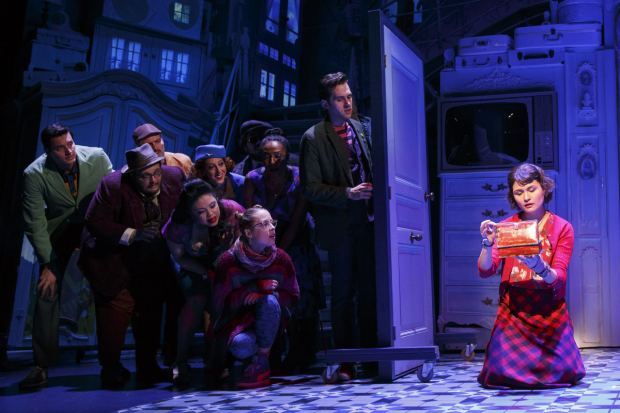Amélie

(© Joan Marcus)
Sixty-seven percent of Broadway theatergoers are women, according to the Broadway League. One might assume from that staggering statistic that a musical with a female title character would be a good bet to get their attention, especially when she is played by the mega-talented Phillipa Soo (Tony nominee for Hamilton). Unfortunately, Amélie is unlikely to top anyone's must-see list this year. This musical adaptation of the 2001 French romantic comedy, now playing at Broadway's Walter Kerr Theatre, is a tepid take on a much bolder film. Suffering from a derivative score, it features a main character who doesn't seem fully present in her own story.
It's 1997, and Amélie (Soo) is France's most adorable stalker. A frigid childhood has left her averse to intimately connecting with other people, so she occupies her free time with solitary pleasures like skipping stones on Canal St. Martin and speculating on the sex lives of her fellow Parisians. When she discovers a box of childhood treasures once owned by a former occupant of her apartment (Manoel Felciano), she tracks him down and concocts a way for him to rediscover the item, just to see his reaction. Her anonymous good deeds lead her to think of herself in saintly terms, like the recently deceased Princess Diana. But when she discovers a scrapbook of discarded photo booth pictures lost by the boyishly handsome Nino (Adam Chanler-Berat), she begins to feel that she wants more than just a brief encounter with his joy.
Craig Lucas (who most recently adapted An American in Paris to the stage) neatly condenses Jean-Pierre Jeunet and Guillaume Laurent's film for the stage without sacrificing too much: The subplot about Lucien (Heath Calvert), a childlike grocer's assistant, is the most notable casualty (although Calvert does get a fun song about figs, which he delivers with aplomb).
The aforementioned bright spot aside, Daniel Messé and Nathan Tysen's score is a generic pop pastiche: "Goodbye, Amélie" is a song written in the style of Elton John and performed by a somewhat ludicrous purple-haired impersonator (Randy Blair). The song "No Place Like Gnome", about a globe-trotting garden gnome, turns into a ho-hum parody of Walking in Memphis. We laugh at Tysen's intermittently clever lyrics, but Messé's music tends to go in one ear and out the other.
Some of this has to do with Bruce Coughlin's orchestrations, a blur of contemplative piano and dreamy harp. Far too regularly he adds a glissando of wind chimes to remind us that what we are seeing is magical. It all feels like a lost opportunity to give this show a distinctive flavor, as Yann Tiersen did with his driving accordion underscoring for the film.
Director Pam MacKinnon does capture the rapid-fire exposition and playful editing of the movie with her cinematic and inventive production. Granted, she cannot always compensate for the inherent tonal contradictions of the script. Still, any moments of awkwardness are quickly banished: The show churns along at a brisk 105 minutes with the help of Sam Pinkleton's musical staging, which seems to re-create a thousand snapshots without ever allowing us to lose focus.

(© Joan Marcus)
Lighting designers Jane Cox and Mark Barton deserve some credit for directing our attention. So does David Zinn, who designed the set and costumes. He has come up with an array of ghastly patterns and itchy sweaters that we don’t doubt belong in 1990s Europe. Leaving center stage open for Pinkleton, Zinn’s set consists of two towers made of chests, armoires, and luggage that seem to have melted together and turned a shade of light blue. A bridge connects them to give Pinkleton and MacKinnon levels on which to stage the work. It reminds us of all the wonders of life hiding in plain sight, like lost treasures in the bottom of a drawer.
In truth, Amélie is not an unpleasant way to spend two hours; it's just not that memorable. Between its blandly whimsical score and inoffensively quirky love story, we cannot shake the feeling that we've seen this show before (and we're pretty sure Chanler-Berat was in it then too, playing the same part).
Soo is as appealing as ever, with a clear and consistent voice that fills the theater. Sadly, she doesn't have much to work with as an actor: The absence of anything resembling an "I want" song until much later in the story keeps us in the dark about Amélie's objectives. It is never actually clear that she dislikes her introverted lifestyle of voyeuristic mitzvahs. Sure, the old man who lives in the apartment below her (a charming Tony Sheldon) tells her she needs to make real human connections, and the ensemble holds up little paper hearts whenever she sees Nino, but Amélie never actually expresses her loneliness in song, leading us to conclude that her need to partner is based mostly on social pressure.

(© Joan Marcus)
Although it is her name in the title, Amélie seems to fade into the background, regularly shoved out of the spotlight by the likes of Elton John and a spastic garden gnome. It's the musical theater equivalent of being talked over in a meeting — a situation likely to conjure neither romance nor whimsy for Broadway's overwhelmingly female audience.










